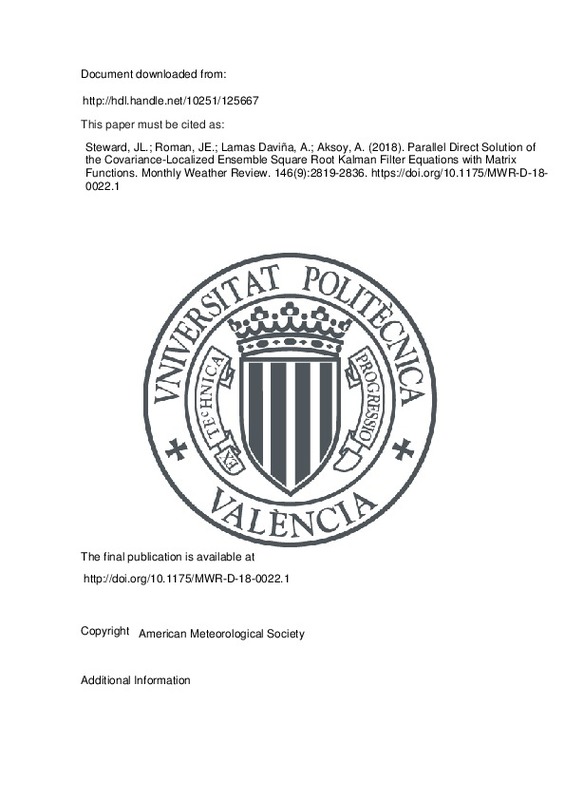Steward, JL.; Roman, JE.; Lamas Daviña, A.; Aksoy, A. (2018). Parallel Direct Solution of the Covariance-Localized Ensemble Square Root Kalman Filter Equations with Matrix Functions. Monthly Weather Review. 146(9):2819-2836. https://doi.org/10.1175/MWR-D-18-0022.1
Por favor, use este identificador para citar o enlazar este ítem: http://hdl.handle.net/10251/125667
|
Título:
|
Parallel Direct Solution of the Covariance-Localized Ensemble Square Root Kalman Filter Equations with Matrix Functions
|
|
Autor:
|
Steward, Jeffrey L.

 Roman, Jose E.
Lamas Daviña, Alejandro
Aksoy, Altug
Roman, Jose E.
Lamas Daviña, Alejandro
Aksoy, Altug
|
|
Entidad UPV:
|
Universitat Politècnica de València. Departamento de Sistemas Informáticos y Computación - Departament de Sistemes Informàtics i Computació
|
|
Fecha difusión:
|
|
|
Resumen:
|
[EN] Recently, the serial approach to solving the square root ensemble Kalman filter (ESRF) equations in the presence of covariance localization was found to depend on the order of observations. As shown previously, correctly ...[+]
[EN] Recently, the serial approach to solving the square root ensemble Kalman filter (ESRF) equations in the presence of covariance localization was found to depend on the order of observations. As shown previously, correctly updating the localized posterior covariance in serial requires additional effort and computational expense. A recent work by Steward et al. details an all-at-once direct method to solve the ESRF equations in parallel. This method uses the eigenvectors and eigenvalues of the forward observation covariance matrix to solve the difficult portion of the ESRF equations. The remaining assimilation is easily parallelized, and the analysis does not depend on the order of observations. While this allows for long localization lengths that would render local analysis methods inefficient, in theory, an eigenpair-based method scales as the cube number of observations, making it infeasible for large numbers of observations. In this work, we extend this method to use the theory of matrix functions to avoid eigenpair computations. The Arnoldi process is used to evaluate the covariance-localized ESRF equations on the reduced-order Krylov subspace basis. This method is shown to converge quickly and apparently regains a linear scaling with the number of observations. The method scales similarly to the widely used serial approach of Anderson and Collins in wall time but not in memory usage. To improve the memory usage issue, this method potentially can be used without an explicit matrix. In addition, hybrid ensemble and climatological covariances can be incorporated.
[-]
|
|
Palabras clave:
|
Tropical cyclones
,
Data processing
,
Numerical analysis/modeling
,
Ensembles
,
Numerical weather prediction/forecasting
,
Data assimilation
|
|
Derechos de uso:
|
Reserva de todos los derechos
|
|
Fuente:
|
Monthly Weather Review. (issn:
0027-0644
)
|
|
DOI:
|
10.1175/MWR-D-18-0022.1
|
|
Editorial:
|
American Meteorological Society
|
|
Versión del editor:
|
http://doi.org/10.1175/MWR-D-18-0022.1
|
|
Código del Proyecto:
|
info:eu-repo/grantAgreement/MECD//FPU13%2F06655/ES/FPU13%2F06655/
info:eu-repo/grantAgreement/MINECO//TIN2016-75985-P/ES/SOLVERS DE VALORES PROPIOS ALTAMENTE ESCALABLES EN EL CONTEXTO DE LA BIBLIOTECA SLEPC/
info:eu-repo/grantAgreement/NOAA//NA14NWS4680022/
info:eu-repo/grantAgreement/NOAA//NA15OAR4320064/
|
|
Agradecimientos:
|
This research was partially funded by the NOAA Hurricane Forecast Improvement Project Award NA14NWS4680022. This work was partially supported by Agencia Estatal de Investigacion (AEI) under Grant TIN2016-75985-P, which ...[+]
This research was partially funded by the NOAA Hurricane Forecast Improvement Project Award NA14NWS4680022. This work was partially supported by Agencia Estatal de Investigacion (AEI) under Grant TIN2016-75985-P, which includes European Commission ERDF funds. Alejandro Lamas Davina was supported by the Spanish Ministry of Education, Culture and Sport through a grant with reference FPU13-06655. The fourth author's work was in part carried out under the auspices of CIMAS, a joint institute of the University of Miami and NOAA, Cooperative Agreement NA15OAR4320064. The authors acknowledge the NOAA Research and Development High Performance Computing Program for providing computing and storage resources that have contributed to the research results reported within this paper (http://rdhpcs.noaa.gov). We thank Jeff Anderson, Shu-Chih Yang, and three anonymous reviewers for their helpful comments and contributions. We also thank Hui Christophersen for providing technical assistance.
[-]
|
|
Tipo:
|
Artículo
|







![[Cerrado]](/themes/UPV/images/candado.png)


